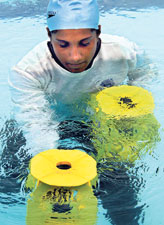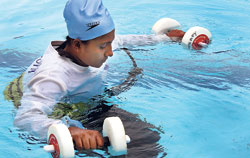It's a swimming pool in the heart of Colombo 7, the NCC to be exact, and in the last lane instead of swimming one person is walking, gingerly raising his feet, one step at a time while another is jogging in the water.
Both Oliver Fernando and Channa Gunasinghe have with them two people by their side while two more are on the edge of the pool watching their movements closely and gently giving instructions such as, "Don't shuffle your feet, raise your legs and walk".
 |
| Dr. Jan Prins |
Mr. Fernando is here because he is unable to walk long distances while Mr. Gunasinghe has had a spine operation and finds it difficult to walk as he loses his balance.
These scenes are a repeat of pioneering efforts since January this year to introduce aquatic therapy in Sri Lanka and the man behind the idea is well-known expert Dr. Jan Prins who has tried and tested this type of rehabilitation in Hawaii since the early 1990s. For 30 long years he has applied the science and technology of aquatic motion to physical rehabilitation, gaining international recognition.
Many people including doctors in Sri Lanka were aware of the need for aquatic therapy but there has been no clinic providing such services. So doctors have been advising their patients just to get into the water, explains Dr. Prins, Founder Director of 'Prins Aquatherapy Sri Lanka' on a recent visit here to review the programme.
Explaining that the clinic provides a comprehensive physical rehabilitation programme that combines aquatic physical therapy and manual therapy, he stresses that it is suitable for people of all ages who have acute or chronic injuries or debilitating conditions. However, to begin the therapy a referral from a medical consultant or a medical officer is a must.
Who will benefit from aquatic therapy?
- Those who have suffered neck, back, shoulder, hip or knee injuries
- Those who have undergone hip or knee replacement surgery
- Those who are recovering from strokes or neurological conditions
- Those who have suffered permanent spinal cord injuries resulting in paraplegia or quadriplegia
- Those who are recovering from work injuries or motor accidents
- Those with cerebral palsy, autism, spina bifida or have undergone amputations
- Arthritis or Post-Polio Syndrome sufferers
- Those who suffer pain and discomfort due to injuries old or new
In the past, people underwent “hydro” or water therapy, as opposed to aquatic therapy, and were confined to Hubbard tanks which were tiny receptacles, where they could only sit and be passive while the water was swirled around them. In aquatic therapy there is sustained activity, with the patients being able to engage in a range of exercises designed specifically for them such as walking, jogging, bicycling, floating etc, MediScene learns.
"This helps incorporate the cardio-vascular component to this type of therapy," says Dr. Prins who holds dual appointments in the Department of Kinesiology and the School of Medicine in Hawaii while also being the Director of the Aquatic Research Laboratory at the University of Hawaii.
Dr. Prins is assisted by registered physiotherapists Suranga Dassanayake and Subashini Jayawardene and other helpers, designated as ‘Aquatic Specialists’ in his programme in Sri Lanka along with a range of custom-designed devices. The day MediScene visited the NCC swimming pool to see the programme in action, was dubbed "auspicious" by Dr. Prins because of the introduction of the aquatic lift to help those who are unable to climb in and out of the pool.
Movements in the water under aquatic therapy are learnt skills and it is essential to be under the supervised care of a clinical therapist, he says, adding that there is no need for the patient to know how to swim to benefit from it.
Referring to the advantages of rehabilitation in the water, he cites the example of stroke victims who are fearful of falling. This becomes an impediment to resuming their day-to-day activity. But in the water that fear goes away. This is also an innovative way to address spinal and muscular injuries, which are difficult to address on land, he says.
For Dr. Prins there are two poignant memories of the success of his programme in Hawaii. He remembers the day a woman suffering from necrosis of the femur who came for aquatic therapy confined to a wheelchair, walked again six months later.
The other was a grossly overweight woman who had not been able to stand on land for 10 years, walking in the water with tears of joy pouring down her face.
Talk is cheap but the bottom line is action. Aquatic therapy is an integral part and not just an adjunct of the rehabilitation spectrum, says Dr. Prins simply.
What it's all about
Buoyancy and viscosity, the two important physical properties of water, are the very elements used in the design of effective exercises in the rehabilitation programme.
When a person enters the water, buoyancy reduces the effects of gravity on the body, allowing patients to begin an exercise programme without increasing pain levels or stress on painful joints. The support of the water allows patients to increase their range of motion while strengthening weakened muscles, explains Dr. Prins.
Meanwhile, viscosity or the variable resistance of the water which matches the effort exercised by the patient reduces the likelihood of re-injury. Therefore, a range of exercise intensities, from gentle to vigorous, can be designed on the needs of the patient.
Different levels
of therapy
- Level 1 - Evaluation by a registered physiotherapist to assess the patient's strengths and weaknesses, to custom-design the therapy programme. The patient then gets into the water and is taught the exercise programme on a one-on-one basis by the physiotherapist.
- Level 11 - The staff monitor the patient's exercise programme to achieve a gradual, steady progression based on sound rehabilitation techniques.
- Level 111 - Once the patient "graduates" and is discharged from formal therapy, he/she can continue in the “maintenance” exercise programme independently at the pool using the equipment.
|



